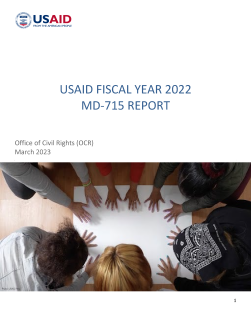OCR organized an action team to prepare the MD-715 report, track accomplishments and progress toward planned activities, produce MD-715 data tables, and analyze workforce data. The Agency’s workforce demographic analysis (race, ethnicity, sex, and disability status) is based on the employment lifecycle (outreach, recruitment, hiring, employee development and advancement, and retention) where employees’ conditions, benefits, and/or privileges of employment may be affected by discriminatory policies, processes, or practices.
OCR coordinated with key stakeholders from across the Agency to analyze USAID’S federal workforce data and assess the Agency’s current efforts to identify and eliminate barriers that impede equal employment opportunities in the workplace. Key stakeholders included the Office of the Administrator; Office of the Chief Diversity Officer (A/DEIA); the Office of Human Capital and Talent Management (HCTM); the Management Bureau (M Bureau); the Bureau for Policy, Planning, and Learning (PPL); the American Federation of Government Employees (AFGE); and the American Foreign Service Association (AFSA).
The Self-Assessment Checklist reflects the overall Agency status as it pertains to each of the 156 total measures that make up the six essential elements, two of which do not apply to USAID. For every deficiency in Part G, there is a corresponding improvement plan in Part H. In FY 2022, USAID met 85.71 percent (132) of the compliance measures as compared to 89.61 percent (138) measures in FY 2021; a decrease of 3.90 percent. The difference in FY 2022 measures is due to the understaffing on the Affirmative Employment team during the fiscal year and an inability to fully execute much of the many EEO program responsibilities. Below is the aggregated scorecard that tracks the Agency's compliance with EEOC's six essential elements of a model EEO Program as it relates to the 154 applicable measures.

